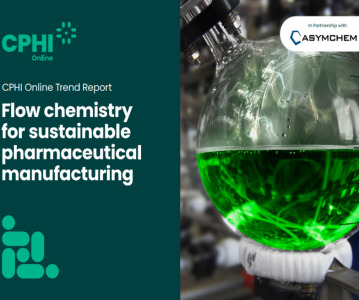Bringing the pharmaceutical supply chain closer to home
.png)
The pharmaceutical supply chain has encountered numerous disruptions in the last few years, impacting procurement, manufacturing, packaging, and distribution operations within the pharmaceutical industry. Read about the rise in calls for near/reshoring, how efforts to near/reshore operational activities in the pharma supply chain require careful consideration, and the challenges and benefits that may arise.
Though the last few decades gave way to a globalisation boom that saw the long-distance outsourcing – or off-shoring – of various business processes including manufacturing, IT support, packaging, and more, recent calls have been made to begin reshoring and nearshoring activities. Defined as the transferring of business operations from overseas markets to a low-cost country closest to the consumer market [i], nearshoring and reshoring are becoming a rising trend in the pharmaceutical sector, with over 70% of healthcare customers turning to nearby countries [ii].
Challenges such as exposure risk throughout the supply chain, increased labour expenses, and a growing awareness and emphasis on environmental, social, and governance sustainability (ESG) principles are forcing pharmaceutical companies to reconsider where they source and produce drug and therapeutic products. These challenges were particularly magnified during the COVID-19 pandemic when imports and exports around the world came to a halt [i].
In this article, we explore the benefits and challenges associated with nearshoring efforts, which parts of supply chain are seeing the most movement in terms of nearshoring/reshoring, and what pharmaceutical players should take into consideration when making high-stake decisions in moving their business practices closer to home.
Why the move?
Location, location, location
The fragility of the pharmaceutical supply chain was on full display during the COVID-19 pandemic, and, while has fared better than other industries according to experts, the effects of import and export disruptions remain. Jaime Mora, Strategic Sourcing Manager at Upwork, comments that “with the pandemic now over, the pharma supply chain is facing a new stage in which outside trends have either a direct or indirect effect on the pharmaceutical supply chain. This means the reconfiguration of the global transport networks, volatility on pricing and availability of chemicals, energy costs, and availability and cost of CAPEX goods to build new capacity.”
An overreliance on a single region for the sourcing/procurement and development of drug products and their associated manufacturing and packaging can lead to marked shortages in APIs, excipients, and other vital pharmaceutical ingredients should an unforeseen circumstance arise. For example, the US Pharmacopeia found that India boasts 114 manufacturing facilities with more than 30 API products approved in the US. The US itself, however, only has three [iii]. The EU hosts slightly more at 45, though still markedly less than India [iii]. Such datasets demonstrate the precarity of the supply chain – should Indian exports come to a sudden halt due to global pandemics, regional natural disasters, or military conflict (not dissimilar to the War in Ukraine), over 30 US drug products that source their APIs from India will need to find a different manufacturer among the 48 available across the US and EU. Even before the COVID-19 pandemic, there were instances in which the pharmaceutical supply chain’s vulnerability was exposed: 2017’s Hurricane Maria shut down many manufacturing and distribution operations in Puerto Rico for such companies as Pfizer, Amgen, and Bristol-Myers Squibb [iv], costing potentially millions of dollars in loss.
Additionally, many European countries and the US are reliant on China and India for the manufacturing of APIs for use in generic medicines such as painkillers and antibiotics, leaving populations of over 750 million individuals at risk of shortages [v]. This overreliance comes as a result of companies prioritising low input costs and circumventing certain regulatory burdens with overseas facilities [vi]. The calls to nearshore and re-shore production and distribution operations cite additional reasons as increased labour expenses, challenges when trying to ramp up speed-to-market, and growing prioritisation of environmental, social, and governance (ESG), which were exacerbated by recent global events [vii]. By fortifying the supply chain against potential disruptions by diversifying one’s portfolio of manufacturing and distribution partners, it is not only businesses that benefit but also the patients who need the medications.
Depending on where pharmaceutical companies are located, and to a lesser extent their primary patient population, certain regions of the world may see an increase in pharmaceutical supply chain operations in the coming years. Sandra Sanchez-Oldenhage, President and CEO of PharmAdvice, comments that “with a strong free trade agreement in place, Mexico is already the second largest US trading partner after Canada, with almost 88% of US-bound exports transported by road, with the benefit of avoiding port congestion and the supply chain delays of recent years. By the end of May 2022, the National Geography and Statistics Institue (INEGI) of Mexico reported a rise of 22.4% in exportations, compared with the same month of 2021.” With priorities shifting within the pharmaceutical industry, some nations may see their manufacturing operations decrease while others can expect to witness growth in their manufacturing and distribution activities.
Different businesses, different priorities
The pharmaceutical supply chain may also be seeing differing perspectives in the shift towards reshoring and near-shoring. “I expect to see the most movement in the manufacturing of generic treatments, which have lost patent protection and therefore revenue dynamic is more constrained, as well as an overhaul or reconfiguration of the distribution and warehousing capabilities (as a result of the developments required to distribute vaccines in a cold chain or controlled temperature environment,” Mora states. “Also expect to see a change in components of the finished products, such as packaging.”
Mora continues: “I do not expect to see big changes in the manufacturing of patent and high-specialty treatments, as these are still of high revenue value, and as such allow for a supply chain strategy with a limited number of manufacturing locations worldwide. Here, the effort should be put into developing ‘mighty’ distribution and storage capabilities. Nevertheless, depending on [intellectual property] and parts insourced/outsourced in the manufacturing process, pieces of the production process required upstream might be executed closer.”
Sanchez-Oldenhage shares a similar view with a focus on the Latin American pharmaceutical manufacturing industry: “Under Biden’s supply chain resilience plan, the US has identified four strategic sectors to mitigate supply chain risk. These include semiconductor manufacturing and advanced packaging, high-capacity batteries, critical minerals and rare earth elements, and pharmaceuticals and APIs. This is an opportunity for pharma to catapult the sector in the country as incentives for nearshoring to Mexico are likely to remain high for companies serving the US market, particularly for these four strategic sector in Biden’s plan.”
Pharmaceutical stakeholders near and far
Fortifying the supply chain against disruptions is a major factor for the increase of nearshoring and reshoring efforts in recent years, however it is important to note the effect of changing demands from key stakeholders within the pharmaceutical supply chain, and what each group has to gain (or potentially lose) from nearshoring and re-shoring efforts.
Regulatory bodies such as the US FDA and EMA may find reshoring and nearshoring efforts attractive due to what may be an increase of up to USD $200 billion in GDP [iv]. Though pharmaceutical operatives historically have gone overseas to ease the strain of regulatory requirements in countries with less developed regulations [iv]. Supply chain relocation may, however, impact certain trade deals and agreements amongst nations in groups such as the World Trade Organization, which may bring unwanted political implications [iv].
For the pharmaceutical industry itself, the advantages may be clear, but there may still exist several challenges to overcome. Relocating manufacturing operations closer to home in Europe, Asia, and Latin America can offer tax rate incentives. For example, the US government might offer a tax deduction of up to 9% should an organisation’s income be from manufacturing. However, relocation of any operation will mean time and money spent in transferring personnel, products, and equipment/technology to a new site, impacting short-term production efforts [iv].
Ultimately, patients and healthcare providers are those who feel the largest impact from pharmaceutical supply chain disruptions. A securitised supply chain can help circumvent disruptions from public health emergencies, global crises, and natural disasters, ensuring access to necessary drugs for patients close to home. However, the question of who will bear the onus of increased costs may be as restrictive for health insurance companies, healthcare providers, and patients in accessing the therapeutics they require.
When to bring things closer to home
The clearest advantages to nearshoring, including but are not limited to mitigating supply chain disruption risks and a greater control of supply chain performance. “The main difference should be seen in transport operations, which in the new state should be shorter, perhaps with less steps and with reduced distances, and therefore easier to manage,” Mora states. However, he caveats that “it is important to be careful in this scenario, as the mere relocation of manufacturing does not ensure the reduction of risk. In the hypothetical case that the new location implements a lean inventory of finished goods, a lean inventory of raw materials, and has further and longer lead time access inputs, nearshoring and reshoring strategies will likely not have the desired effect.”
Mora also advises keeping an eye out for any potential losses: “New capabilities mean new costs, as well as the potential to lose some knowledge... there are times in which not only the loss of high-impact intellectual property (e.g. production knowledge) is felt, but even transactional knowledge too (e.g. communication method and pace). It is for this same reason that special attention must be put on the complete system of quality, as well as having sufficient knowledge of the manufacturing system.”
Though certain regions may be attractive options to which nearshoring operations can be moved, there are several challenges that must be assessed before shifting production to these areas. Sanchez-Oldenhage gives a few examples of structural, operational, and regulatory challenges of shifting manufacturing to Mexico for the US pharma market: weak enforcement of laws and internal corruption can deter business activities within Mexico, and affect perceptions of the business environment; while infrastructure quality is better in industrial hubs around the Bajío region and northern Mexico, improvements can be made to strengthen Mexico’s position as an important manufacturing hub; the regulatory agency COFEPRIS has caused concern for the pharmaceutical supply chain operating within LATAM due to a major restructuring amid alleged corruption concerns, causing significant delays in market authorisations, import permits, and GMPs – such delayed responses may not make much difference in the grand scheme of nearshoring and reshoring efforts for some pharmaceutical companies.
As a result of these concerns, there are several considerations pharmaceutical players must take into account when looking to move their operational activities closer to home, as laid out by Mora: “For scenarios in which the operations are owned, it is important that the people in charge of the new operations have access to the tools and connections that allow them to solve problems... knowledge is key. Major questions to ask when thinking about nearshoring/reshoring are: What capabilities do we need to properly manage? The answer would reside in critical inputs: energy, access to key materials, regulation, talent, and other enabling capabilities. The new location must have core capabilities in two main frameworks: Productivity Growth and the appropriate level of Research and Development.”
“There is a great incentive for North American countries to trade with each other and promote nearshoring,” Sanchez-Oldenhage mentions. “Given the advantages [such as] lower overhead costs and ease of logistics, many of the world’s largest pharma companies already operate facilities in Mexico, and nearshoring could further increase international investment. At the same time, the US has had trade disputes with China, a major pharma exporter, in recent years, so honing [in on] this opportunity is a must.”
“China has increased its productivity output dramatically in the last 30 years, perhaps the largest growth of productivity in history,” Mora comments on China as a leading example of a pharmaceutical manufacturing powerhouse. “It is difficult to know how this was achieved, but it is a lesson to the world of what can be achieved in such a short amount of time. While currently, it seems that its productivity growth is decelerating, I perceive the capacity to still be there, and it will become more and more productive. This means that in a few years’ time, when the scars of the pandemic [fade], the pressure will be on to increase efficiency and reduce cost. If the new nearshoring/reshoring partners remain stuck in their old (current) competitive advantages, while the global competition improves, we will be living a déjà vu – we will again face the temptation to offshore operations. The only way to have options and be less pressured to fall into the same trap is to pressure new partners to constantly develop more productivity, knowledge, and IP, and consequently, more competitiveness.”
The future of manufacturing: near or far?
“The true extent of nearshoring/reshoring still needs a few years to show lasting effects, and if you’re not [already making the move], you will need to wait for opportunities in order to act,” Mora observes on the nearshoring/reshoring ‘trend’ - will it indeed be simply a trend or will the pharmaceutical supply chain witness a lasting change in how it operates? There are several factors that may change the course of the future of pharmaceutical manufacturing.
Innovations in manufacturing
The burden of nearshoring and reshoring manufacturing activities can be alleviated to some degree with certain innovations in the manufacturing process. Continuous manufacturing and process analytical technologies for final dosage manufacturing can significantly expand domestic manufacturing and benefit nearshoring or reshoring efforts by lowering operating costs compared to batch methods used in offshore activities [viii].
Continuous manufacturing involves drug production in fully integrated processes that run from beginning to end uninterrupted. Batch production, in contrast, sees the process segmented into various steps that can often be slow and time-consuming [ix]. Condensing the manufacturing process to a few days from months can lower costs and promote further innovations in automation and robotics. Sustainability concerns can also be addressed with the implementation and improvement of regular quality control checks throughout the process [ix]. Most notably, continuous manufacturing in a domestic setting may mitigate a large portion of risk within a sensitive supply chain by offering a more reliable pipeline from beginning to end [ix].
Strategic procurement partnerships in the supply chain
Alternatively, companies may turn to domestic and regional partnerships, especially related to procurement, that will increase supply chain resiliency [x]. Partnerships among pharmaceutical companies, contract manufacturers, packagers, and logistics service providers can accelerate and facilitate reshoring efforts. These partnerships may even lead to purchasing consortiums, which increase the buying power of two or more organisations and leverage their shared economies to scale-up materials, services, and solutions on offer. EY found that the top benefits of consortiums related to risk sharing, learning and collaboration among partners, and cost savings, with 82% of pharmaceutical supply expenditures negotiated through purchasing consortiums [x].
Additionally, various sustainability concerns may be addressed with the identification of the right partners.
Regional hubs – diversifying the supply chain
What may be seen more than direct nearshoring or reshoring efforts is an effort to create a diverse portfolio of “regional hubs”, as Mora calls them. “The more proactive option is to look to develop regional capabilities. Given that, in many countries, the largest and most important clients are governments, small and mid-size pharma companies tend to develop a supply chain that is optimised solely to satisfy in-country demand and its biggest clients (governments),” Mora states.
He also advocates for increased collaboration and partnerships throughout the supply chain to mitigate risks of disruption: “My challenge to small/mid-size pharma is to become more proactive in creating ‘regional hubs’ of development. Putting together pieces of a puzzle with meaningful collaboration between companies on this scale can include: collaborating to invest and in-source the manufacturing of common raw materials, share inventories that could be shared seamlessly, synchronise/standardise aspects of the supply chain that allows them to perform as a back-up, or increase the partner capacities of each by sharing as many supply chain aspects as possible (e.g. packaging). This will increase their capabilities and has the potential to create a regional hub of competitiveness for the selected capability, allowing them to compete better in the present and the future.”
Nearshoring to a country closer to consumers and patients and setting up regional hubs may also create integrated supply chains across several industries (including pharma) within that nation, to the benefit of all: “The development of integrated supply chains between Mexico and the US – which cover diverse economic sectors such as manufacturing, automotive, aerospace, agriculture, and textiles – has contributed to Mexico retaining its place as the second-largest US trade partner in 2022,” Sanchez-Oldenhage states. “If more companies begin nearshoring to Mexico, it will have a sizeable impact and significantly improve Mexico’s economic standing beyond the 5-year outlook.”
Summary
Discussions surrounding nearshoring and reshoring pharmaceutical development, manufacturing, and distribution operations may turn political at times, but the ultimate goal remains the same: to bring the right therapeutics to the right people.
Building supply chain resiliency against unforeseen disruptions continues to be a focus for many companies, not only to withstand economic blows but also to better position themselves within the supply chain as a reliable healthcare partner. The question to be answered now is the length to which these companies will invest in fortifying their supply chains and operational procedures. “To capitalise on these opportunities, pharma organisations must not only understand the breadth and depth of the challenges in the country/region, but also ensure that they are well equipped to navigate security, operational, and regulatory risks as they transfer one set of risks for a different set,” Sanchez-Oldenhage advises.
References
[i] Nearshoring in Mexico: The Healthcare and Pharma Opportunity [Accessed June 28, 2023] https://mexicobusiness.news/health/news/nearshoring-mexico-healthcare-and-pharma-opportunity
[ii] Nearshoring: the future of the pharmaceutical and healthcare sector [Accessed June 28, 2023]https://supplychaindigital.com/sustainability/nearshoring-future-pharmaceutical-and-healthcare-sector
[iii] Global API Manufacturing Findings [Accessed July 11, 2023]https://www.usp.org/news/medicine-supply-map-releases-global-api-manufacturing-findings
[iv] The growing benefits to reshoring pharma operations [Accessed July 11, 2023]https://www.pharmamanufacturing.com/compliance/regulatory-guidance/article/11296301/the-growing-benefits-to-reshoring-pharma-operations
[v] How dependent is the European pharma supply chain on China? [Accessed July 14, 2023] https://pharmaoffer.com/blog/european-api-dependency/
[vi] US Pharmacopeia report finds high reliance on Indian manufacturers for APIs [Accessed July 14, 2023] https://www.linkedin.com/pulse/nearshoring-implications-supply-chain-ups-healthcare/
[viii] Reshoring Pharmaceutical Manufacturing to the US: Can We Do It? [Accessed July 14, 2023]https://www.pharmtech.com/view/reshoring-pharmaceutical-manufacturing-to-the-us-can-we-do-it
[ix] Why reshoring drug production means embracing continuous manufacturing [Accessed July 17, 2023]https://pharmaphorum.com/market-access-2/why-reshoring-drug-production-means-embracing-continuous-manufacturing
[x] Reshoring US pharma manufacturing [Accessed July 17, 2023]https://www.ey.com/en_us/life-sciences/reshoring-us-pharma-manufacturing
Related News
-
News CPHI Pharma Awards 2024: Meet the winners from the CPHI Celebration
This year we had a lot to celebrate, the 35th Anniversary of CPHI, and our esteemed award winners, of which we included two additional categories this year, the Future Leader award, and Woman of the Year award. -
News Women in Pharma: C-Suite Journeys in Leading Diversity
In this CPHI Milan special of our monthly series, we sit down with our panel of C-suite executives speaking on the ‘Leading with Diversity: The CEO Journey’ panel at this year’s show. -
News The BIOSECURE Act: implications for the pharma supply chain
On September 9, 2024, the US House of Representatives voted to pass the bill titled the BIOSECURE Act (the Act), which lists several Chinese companies in the pharmaceutical supply chain. The Act will prohibit American companies from contracting or doin... -
Sponsored Content CPHI Online Trend Report: How can flow chemistry help businesses achieve their sustainability goals?
In our latest CPHI Online Trend Report, we partner with Asymchem to understand the innovative potential of flow chemistry for API manufacturing, especially in regards to meeting sustainability goals. -
News CPHI Milan Speaker Spotlight: CDMO relations with Pharma and Start-Ups
In the run-up to CPHI Milan, we sit down with some of the experts and thought-leaders speaking at this year’s conferences. -
News Women in Pharma: Advocating for trans healthcare in pharma
In our monthly series on women in the pharmaceutical industry, we interview leading experts in the pharmaceutical supply and value chain to discuss the importance of gender diversity in healthcare, the workplace, and beyond. -
News A Day in the Life of a Vice President in R&D & Engineering
In the Day in the Life of Series, we've already had the chance to get to know a range of people in various roles in the pharma industry. In the latest interview we get a glimpse into the R&D side of things from Jennifer Sorrells, Vice Presiden... -
News CPHI Podcast Series: analysing supplier audits with the PSCI
This episode of the CPHI Podcast Series, hosted by Digital Editor Lucy Chard, goes through the results from the recent audits from the PSCI conducted on suppliers across the pharmaceutical industry, looking into ESG outcomes.
Position your company at the heart of the global Pharma industry with a CPHI Online membership
-
Your products and solutions visible to thousands of visitors within the largest Pharma marketplace
-
Generate high-quality, engaged leads for your business, all year round
-
Promote your business as the industry’s thought-leader by hosting your reports, brochures and videos within your profile
-
Your company’s profile boosted at all participating CPHI events
-
An easy-to-use platform with a detailed dashboard showing your leads and performance





.png)

